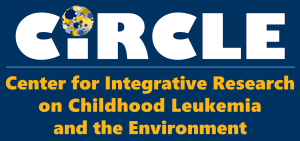Parental Occupational Exposure and Childhood Leukemia
In a manuscript that has been conditionally accepted for publication in the peer-reviewed scientific journal, Environmental Research, CIRCLE Director, Catherine Metayer, and CIRCLE investigator, Alice Kang, investigated the role that parents’ exposures to chemicals at work play in their children’s health. Dr. Metayer and Ms. Kang used 19 task-based job modules to examine the relationship between occupational exposure to organic solvents and the risk of leukemia in the workers’ offspring. The study population was comprised of Hispanic (48%) and non-Hispanic (52%) children with acute lymphoblastic leukemia (ALL; n=670), acute myeloid leukemia (AML; n=104), and controls (n=1021), who were enrolled in California from 2000-2008. Among children with non-Hispanic fathers, none of the exposures evaluated were associated with risks of ALL and AML. In contrast, exposure to any organic solvents in Hispanic fathers was associated with an increased risk of childhood ALL. Exposure to chlorinated hydrocarbons was more strongly related to leukemia risk than exposure to aromatic hydrocarbons, glycol ethers, or other hydrocarbon mixtures. The investigators also observed an increased risk of ALL with exposure to combustion exhausts. Moderately elevated risks of ALL were seen with exposure to metals, paints, and wood dust, although these relationships were not statistically significant. Overall, the prevalence of exposures to chemicals was low in mothers, except for disinfectants, and no associations were reported for risk of childhood ALL and AML. In conclusion, the authors reported associations between paternal occupational exposures to chlorinated hydrocarbons and combustion exhausts, and risk of ALL in Hispanic children.


